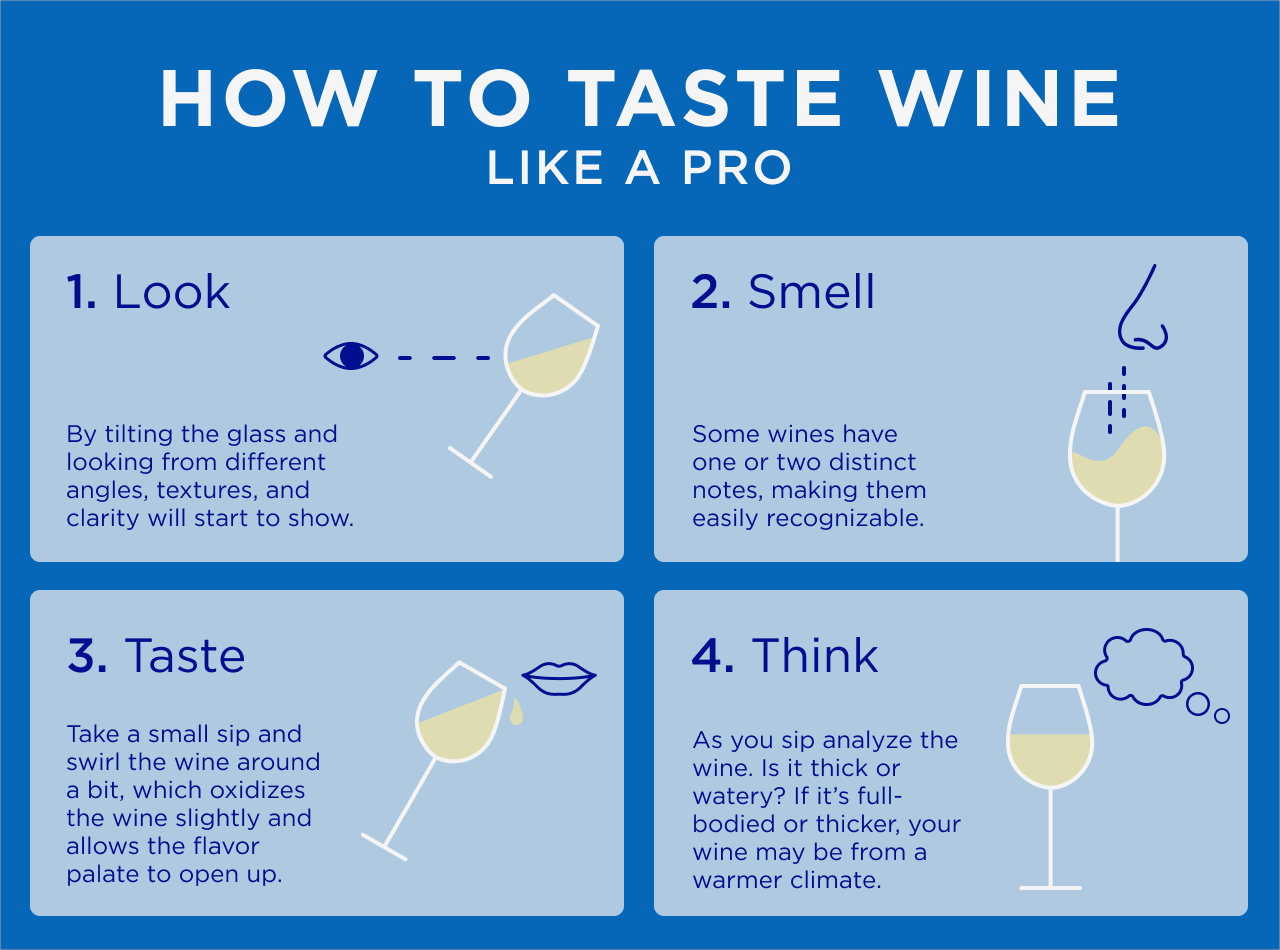How to Taste Wine Like a Pro
As a fellow wine lover, you know there’s nothing more fun than gathering some of your favorite wines and having a tasting party, whether by yourself, with friends, or at your favorite local winery.
For newbies, discovering how to drink wine properly is eye-opening and exciting as you learn what makes a wine complex and unique.
In today’s wine-tasting guide, we’re lending a few tips for how to taste wine better so that you can know exactly what to look for when tasting a wine.

Prepare Your Setup
The type of wine you’ll be sipping all comes down to your preferences, though we suggest a mix of red and white wines for a bit of variety. Tasting light and full-bodied wines side by side, like Pinot Noir and Cabernet Sauvignon or Sauvignon Blanc and oak-aged Chardonnay, for example, will show you a range of both categories.
What You’ll Need:
-
A bottle of wine, slightly chilled
-
Wine glasses
-
Ample daylight to see the colors in your wine
-
A solid surface for tasting
-
A decanter or aerator, if needed
Now that your wines are selected and your setup is ready, it’s time for the best part.
Tilt the Wine
After pouring yourself a glass of wine, look into the glass and hold it up to the light. By tilting the glass and examining the wine from different angles, textures and clarity will start to show.
Look for color intensity. Red wines can range anywhere from deep purple to a pale ruby hue. White wines can either be almost completely clear or a deep golden color.
Check to see if the wine is completely clear or slightly murky or if there are any bubbles.
Does the wine cling to the glass, or is it more watery?

Examine the Wine’s Color
Did you know that some wines have such a distinct look that it’s possible to identify them by color alone? Malbec, for example, is known for its intense purple-black color, while Nebbiolo, Pinot Noir, and Rosé have lighter, more transparent colors.
Look at the outer rim of your wine as you tilt it to the side. If the outer rim is faded orange or brown, this could be a sign that the wine’s aged. Younger wines will usually have a vividly colored rim.
For both reds and whites, a deep color suggests that the grapes fully ripened before winemaking.
If streaks of wine cling to the glass, these are known as wine legs. It’s possible that wine legs could indicate higher alcohol levels or more residual sugars, like with the syrupy dessert wine Port. The heat from the alcohol may cause more liquid to evaporate, causing it to stick to the glass.
If your wine is bubbly and not sparkling wine, this could mean it comes from a cool climate.
Now that you’ve examined your wine thoroughly, it’s time to give it a swirl.
Swirl the Wine
Swirling wine in the glass allows more oxygen in, opening up more flavors and aromas. This can also be achieved by allowing your wine to aerate in a decanter for at least thirty minutes or pouring it through an aerator, allowing it to oxidize instantly. This mainly applies to robust red wines like Syrah of a French Bordeaux as they are heavier and need more oxygen to reveal their complexity.
After swirling the wine, it’s time to give it a good sniff.
Smell the Wine
Inhale deeply, allowing your olfactory senses to clue you into the aromas.
Some common aromas include:
-
Fruit like citrus, stone fruit, orchard fruits, or tropical fruits.
-
Florals such as elderflower, honeysuckle, or violet.
-
Spices like cloves, cinnamon, vanilla, or nutmeg.
-
Nutty notes like walnuts, coconut, coffee, or brioche.
Unique aromas may include:
-
Animal smells such as leather or game meats.
-
Petrol like with aged Riesling.
-
Vinegar or mold, which could indicate the wine has gone bad.

What a Wine’s Smell Can Tell You
Some wines have one or two distinct notes, making them easily recognizable. Sauvignon Blanc with its green pepper tang, Cabernet Sauvignon with rich blackcurrants, and Gewürztraminer with its lychee scent. But you can also learn more about a wine based on its smell, such as climate, region, age, and winemaking.
Here are some examples:
-
A wine with a rich or jammy scent is a warm climate wine.
-
Chablis and Loire wines have a distinct stoney note, while Medoc and Bordeaux wines are much earthier.
-
Bold Chardonnay will smell buttery or like yeast as it has undergone malolactic fermentation.
-
Older reds develop tobacco, baking spice, or dried fruit notes, while aged white wines start to smell toasty or oaky.
-
If a wine smells like vanilla, coconut, or clove, it could be a sign it was aged in oak barrels.
Now that we’ve looked at and smelled the wine, there’s only one thing left to do!
Taste the Wine
The last thing you want to do for this step is to take a big gulp of your wine. Instead, take a small sip and swirl the wine around a bit. Like swirling in the glass, this oxidizes the wine slightly, allowing the flavor palate to open up on your taste buds.
Pay attention to the five primary tastes: bitter, sweet, salt, acid, and savory, while you’re sipping to get the full effect of the tasting notes, which may be slightly different or similar to the aromas mentioned earlier.
Pay Attention to Acidity and Texture
As you savor your first sip, what does the wine taste like? Is it thick or watery? If it’s full-bodied or thicker, your wine may be from a warmer climate, like an Australian Shiraz.
If there is a solid astringent taste on your palate, this means your wine is higher in tannins. This one is specifically for red wine, as red wines result from the grape skins, seeds, and stems soaking in the juice during winemaking. This is what gives the wine its red color and those organic, puckering notes known as “tannins.”
Smooth tannins could also indicate that the wine is mature, while extremely astringent, unpleasant tannins could suggest that the grapes were underripe.
A sweet wine tells you that there is a high amount of residual sugar, which is the case with late-harvest wine, wines affected by noble rot (like German ice wine), or fortified wines (like Port). A dry wine means there is little to no residual sugar content.
Wines with high acidity are often from a cool climate, but this can also be a marker of grape variety. Tangy white wines like Riesling or brut Champagne are noted for their acidity. So if you’re sipping a white wine and notice the acidity has a bit of a bite, there’s a high chance it’s a Riesling.
If your wine has warmth, this could be a sign of high alcohol content, which usually means warm climate wine. Red wines like Grenache or Zinfandel naturally have high alcohol levels and fortified wine, so keep this in mind.
Lastly, if a wine has a long finish, it usually means you’ve picked a high-quality wine. Well done!

Wine Taste With Confidence
Now that you know more about the complex and alluring world of wine tasting with these tips, you’re ready to start tasting like a pro!
If you’d like to enrich your wine knowledge further, check out our Podcast and Wine Online 101 for everything related to the world of wine.
As a leader in the alcohol e-commerce wine industry, we can’t wait to share our expert knowledge with you.